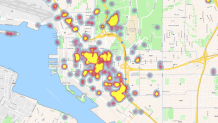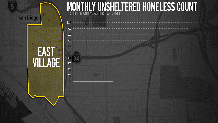You can’t talk about the East Village without talking about homelessness.
For many San Diegans, the neighborhood encompasses the heart of the county’s homeless problem. Tents dot sidewalks throughout the area. Imperial Avenue intersects entire encampments, with trash on the ground, bio waste, drug paraphernalia and more. It can be shocking to see for people who only visit the area every now and then.
“I think it’s gotten worse,” Jeff Stapp told us. “Used to be when we come down here it was centrally located in one area. Now it’s all over the place. It’s really sad. It really is.”
“I just feel bad for people,” Debra Nunez said. “They’re human beings. I'm not bothered by them at all, I just wish we could help them more.”
Get top local stories in San Diego delivered to you every morning. >Sign up for NBC San Diego's News Headlines newsletter.
But on Thursday the homelessness problem was harder to see. On Opening Day for Major League Baseball, the Padres welcomed baseball fans back to Petco Park to watch their team on the big screen. But the area around the stadium was conspicuously missing the usual signs of homelessness.
David Carrera told NBC 7 Investigates the change is superficial and temporary by design.
“There’s an event going on in Petco Park and magically the transients and the homeless have disappeared,” he said. “It’s because the police are out here at six in the morning and they’re shoving everyone out of the area to make it seem for the tourists that, ‘Hey the East Village is a great place.’ And once upon a time, it was. But things have changed. So I feel like it’s almost fake at this point.”
Local
Carrera would know. He’s lived in East Village for four years and also works there. He has a message for Mayor Todd Gloria.
“Honestly I would love to know if he ever walks around downtown,” he said. “I would love to see [Gloria] out here on a Friday, Saturday, Sunday afternoon when there’s not an event.”
NBC 7 Investigates spent weeks trying to quantify the problem but discovered that’s not easy. Local government agencies and nonprofit groups rely on yearly "point in time" counts of the homeless, conducted by the San Diego Regional Task Force on Homelessness. While critics say those counts aren’t perfect, nobody was even counting in 2021 because of the pandemic, and the 2022 numbers haven’t been released yet. The group hopes to publish its latest report at the end of April or early May. Preliminary data in this heat map shows high concentrations of homeless downtown, including in East Village.

The San Diego Regional Task Force isn't the only group trying to get a handle on homelessness. The Downtown San Diego Partnership conducts monthly counts of neighborhoods with heavy homeless populations. It has data dating back to 2012, and the total count of unsheltered individuals is higher now than ever. Data shows 740 people slept on East Village sidewalks in February, the highest number since the group categorized individual neighborhoods five years ago.

Carerra says the situation is unsafe for both the homeless and the people who live, work and play in East Village. He recalls when a homeless man held up the restaurant where he works with a butter knife swiped from a dining table.
“There were eight police officers that responded, and at that point, he was long gone,” Carerra said.”You know, it's just, what do you do?”
NBC 7 Investigates analyzed police calls for service in East Village for the last three years and found that the number of calls for the most serious crimes increased each year.
San Diego City Councilman Stephen Whitburn represents the East Village neighborhood – where he also lives. He believes the city’s efforts to increase shelter bed capacity and build more affordable housing will work in the long run.
“I do think there are things we can do in the short term to help alleviate the situation,” Whitburn said.
One possible solution is called a safe village, designated land where people can live in tents, use hygiene facilities and access health and other resources. East Village Residents Group President Kathleen Hallahan is on board with a safe village, with one caveat.
“My feeling is as long as they don’t concentrate more people here, that’s OK,” Hallahan said. “But we are taking the lion’s share of all the homeless throughout the county. We are taking the lion’s share of the permanent supportive housing.”
Hallahan fears adding more homeless services in East Village will only attract more homeless people to the neighborhood. She would rather see those resources spread throughout the county.
“Yeah it’s a problem and it’s a concern,” she said. “Because we all are investing a lot of time and all our resources in this neighborhood and our lives. And there doesn’t seem to be an understanding of what’s at stake.”
She feels East Village still has a lot to offer, and told us, “We wanted to live in a place that had more gritty, creative, innovative energy, and East Village is it and it’s still that way.”
But others say they can’t keep waiting for a solution to a humanitarian crisis that appears to be getting worse.
“Our taxes are still astronomical,” Carerra said. “But where is the money actually going? It’s a very interesting aspect and makes me think maybe East Village is not for me anymore.”
Editor's note: the headline has been updated to reflect that the homeless population in East Village nearly doubled, not more than doubled.



